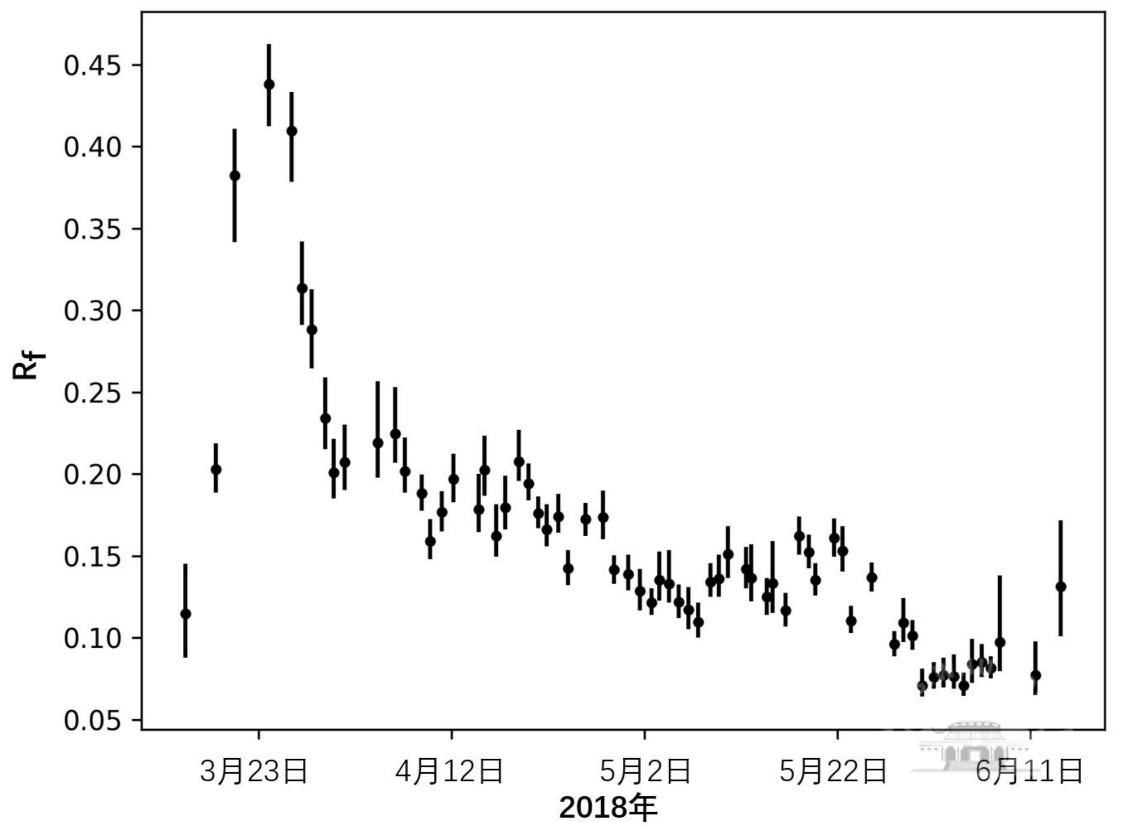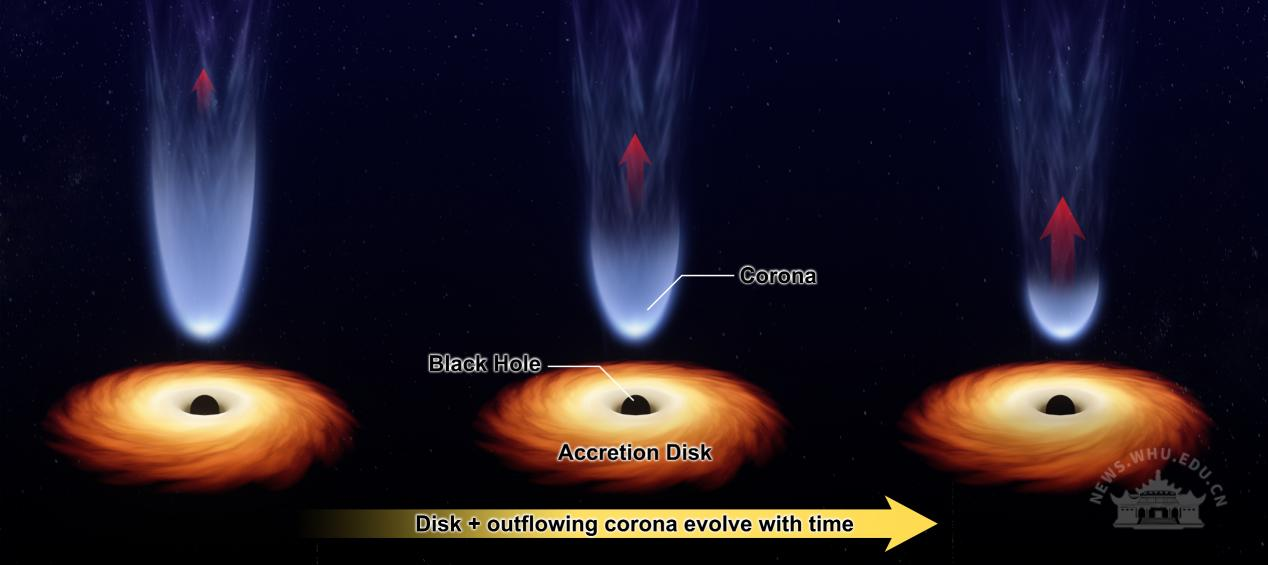On February 15th, Nature Communications published online the latest scientific research results of the Hard X-ray Modulation Telescope (HXMT) satellite. The study reveals that the black hole double star has escaped from the black hole. A high-speed plasma stream moving outwards with a gravitational field (hereinafter referred to as the corona), and the evolution of the corona's velocity has been observed for the first time in a black hole binary star. Studies have shown that while the corona tends to shrink toward the black hole, it also moves outward at a relativistic speed, and the smaller the scale of the corona, the greater the speed. The results provide an important basis for studying the motion of coronae in the black hole accretion process.
The paper is entitled “Insight-HXMT observations of jet-like corona in a black hole X-ray binary MAXI J1820+070”. It was jointly accomplished by researchers from Wuhan University, the Institute of High Energy Physics (IHEP) of the Chinese Academy of Sciences (CAS) (hereinafter referred to as the Institute of High Energy Physic), National Astronomical Observatories, Nanjing University and Tsinghua University. Wuhan University is the first institution. You Bei, a researcher at the Center for Astrophysics of Wuhan University, is the first author. The co-corresponding authors are Wang Wei, a professor from the School of Physics and Technology of Wuhan University and Zhang Shuangnan, a researcher from the Institute of High Energy Physics, Chinese Academy of Sciences. This achievement by Wuhan University makes an important contribution to the scientific findings of the Insight-HXMT satellite, China’s first space X-ray astronomical satellite.
As early as the 1960s, astronomers detected X-ray sources in the Milky Way. Among these X-ray sources, Cygnus X-1 was the first binary star system that provided evidence for the existence of black holes. With the development of astronomy, more and more black hole X-ray binaries have been discovered in the Milky Way. It is generally believed that in black hole X-ray binaries, with the black hole’s gravity, the companion star material gradually rotates toward the black hole, forming an accretion disk, and a high-temperature corona is formed near the inner region of the accretion disk. However, how coronae move near black holes remains a mystery in the study of compact objects.
In March 2018, the black hole X-ray binary MAXIJ1820+070, about 11,300 light-years away from us, erupted and was one of the brightest X-ray sources in the sky for a long time. The Insight-HXMT satellite made frequent observations of its eruption. In 2020, by analyzing time-varying data from the Insight-HXMT satellite, the research team led by the Institute of High Energy Physics (IHEP) found in MAXIJ1820+070 the highest energy low-frequency quasi-periodic oscillation (QPO), providing evidence of relativistic jets from the event horizon of the black hole (out-flowing plasma at high speed). Recently, by analyzing the energy spectrum data from the Insight-HXMT satellite, a research team led by the Center for Astrophysics of Wuhan University found that as the intensity of X-ray radiation gradually decreases, that is, when the corona gradually weakens, the illumination to the accretion disk (or the ratio of intensity emitted towards the disk to that emitted to infinity) also weakens. The research team points out that the luminosity of the X-ray photons emitted from the corona on the accretion disk depends on the speed of the corona and the gravitational field of the black hole.
It is still unknown how the corona moves during the accretion of a black hole. Previous studies have focused more on theory, and there is very little observational evidence. Theoretically, when the corona moves outward at a relativistic speed, the relativistic beaming effect will weaken the corona’s radiation to the accretion disk. The X-ray timing analysis of MAXIJ1820+070 in the same period shows that when the X-ray radiation intensity gradually decreases, the geometric scale of the corona tends to shrink (that is, the scale is decreasing). The closer to the black hole, the stronger the gravitational bending effect, and the larger the opening angle of the accretion disk relative to the corona. There should have been a larger proportion of the X-ray photons emitted by the corona irradiated to the accretion disk, enhancing the corona’s luminosity to the accretion disk. This conflicts with the research team’s results of the Insight-HXMT observations. The research team points out that the most reasonable explanation for this phenomenon is that as the corona is shrinking, the plasma in the corona is out-flowing at a relativistic velocity. It provides independent observational evidence and a physical explanation for the Insight-HXMT satellite research team that has discovered a relativistic jet very close to the black hole. The research team further discovered that the smaller the coronal scale, the greater the velocity, so the relativistic beaming effect of the coronal suppresses the gravitational bending effect of the black hole. This research, for the first time, systematically describes the evolution of the velocity of the plasma stream escaping the gravitational field of the black hole during the outburst of a black hole (BH) X-ray binary, which is of great significance for understanding black hole accretion and relativistic effects.
Through its time-variant data, the Insight-HXMT satellite discovered a plasma flow moving outwards at a relativistic velocity and its process near the event horizon of MAXIJ1820+070. Besides, by using its energy spectrum data, it also found that the plasma stream was moving outwards at a relativistic velocity and the evolution of its velocity. These two mutually corroborating research findings demonstrate the comprehensive advantages of the Insight-HXMT satellite over research on time-varying broad energy bands and spectroscopy.

The evolution of the intensity of the corona on the accretion disk

The Insight-HXMT satellite detected the dynamic evolution of the corona for the first time.
Link to the paper: https://www.nature.com/articles/s41467-021-21169-5
Rewritten by Lin Wanping
Edited by Qin Zichang